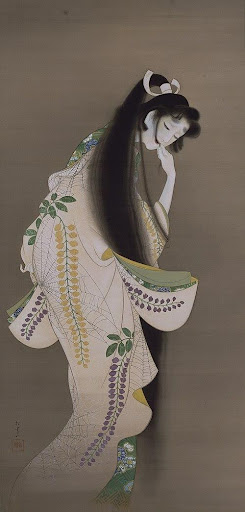7.焔(Honō)
異彩を放つ、情念の極致を描いた傑作

《焔・ほのお》は、上村松園が1918年に描いた異色の傑作。彼女自身が「たった一枚の凄艶な絵」と語ったほど、特別な意味を持つ作品。《焔》のモチーフは『源氏物語』の「葵の上」を題材とした能《葵上》に登場する六条御息所の生霊。嫉妬に狂い、恋敵を呪う女性の情念を描いている。着物には藤の花と蜘蛛の巣が絡みつき、女性は髪を噛みしめ、振り返る姿勢で描かれ、目には金泥が施されて妖しく輝いている。能面や幽霊画の研究を重ね、女性の内面に潜む嫉妬・苦悩・狂気をリアルに表現した。衣装は平安時代ではなく桃山時代風に描かれ、絵画としての効果を重視。小説『序の舞』(宮尾登美子)にも登場し、現代でも多くの人々の心を揺さぶる作品である。
Honō (Flame)
A striking masterpiece depicting the pinnacle of emotional intensity
Painted in 1918, Honō is one of Shōen Uemura’s most distinctive and unique works. Uemura herself described it as “the one and only hauntingly beautiful painting” of her career, reflecting the deep significance it held. The subject is the vengeful spirit of Lady Rokujō from the Noh play Aoi no Ue, based on The Tale of Genji. Consumed by jealousy, she curses her romantic rival.
The woman is shown biting her hair and turning her head, her eyes gleaming eerily with gold pigment. Her kimono is entwined with wisteria blossoms and spiderwebs. Uemura studied Noh masks and ghost paintings extensively to portray the jealousy, suffering, and madness lurking in the female psyche with haunting realism.
Though the story is set in the Heian period, the costume is depicted in a Momoyama-period style, emphasizing the dramatic effect. The painting also appears in Tomiko Miyao’s novel Jo no Mai, and continues to resonate deeply with modern audiences.
お問い合わせ
〒154-0024 東京都世田谷区三軒茶屋1-39-7